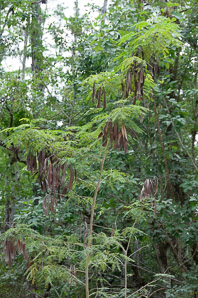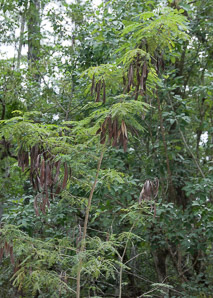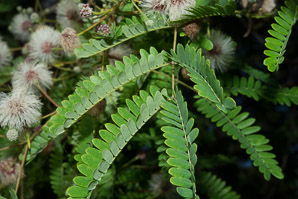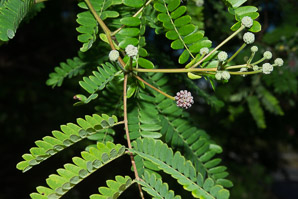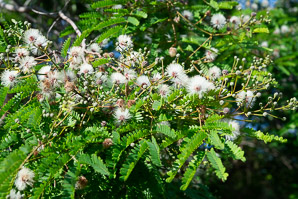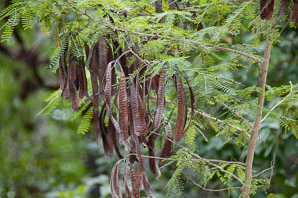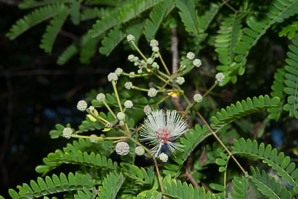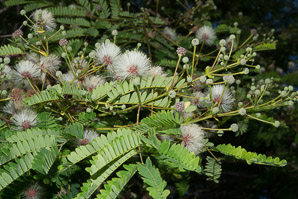
|
Leucaena leucocephala (Lam.) de Wit White leadtree, jumbie bean, jumbay, river tamarind, pearl wattle, ipil-ipil, tan-tan, white popinac, coffee bush, cow tamarind, miusina
White leadtree is native to northern Central America and southern Mexico. It has become naturalized throughout the tropics. It is considered one of the 100 worst invasive species, growing in dense thickets that crowd everything else out. Don’t even think about planting these! They prefer riparian zones (areas around rivers), but also thrive in roadsides, open woods, gardens, disturbed habitats, and coastal areas. Plants: Shrubs or small trees, 6½-33′ (2-10 m) high. Young stems are green and densely covered in fine grayish hairs. Older stems are smooth, gray or gray-brown, with multiple raise lenticles. Leaves: bipinnate, up to 10″ (25 cm) long. Each leaf has about 12 pairs of opposite, lanceolate leaflets ¼-⅜″ (9-12 mm) × 1/16-⅛″ (2-3.5 mm). Flowers: Resembling fuzzy balls ¾″ (1.9 cm) in diameter, flowers are white, aging to yellow and brown. Fruits: Seed pods are dark brown, nearly flat, 3-9″ (8-23 cm) long × ⅜-¾″ (1-2 cm) wide, each containing about 20 seeds. Each seed is glossy brown, oval, flat, and ⅛″ (6 mm) long. Online References:
The University of Florida IFAS Center for Aquatic and Invasive Plants 4/11/2015 · Loop Road, Big Cypress National Preserve, Florida 4/11/2015 · Loop Road, Big Cypress National Preserve, Florida 4/13/2015 · Ernest F. Coe Visitor Center, Everglades National Park, Florida · ≈ 8 × 5″ (19 × 13 cm)
Leucaena leucocephala description by Thomas H. Kent, last updated 5 Sep 2023. © FloraFinder.org. All rights reserved. |
4/13/2015 · Ernest F. Coe Visitor Center, Everglades National Park, Florida · ≈ 8 × 5″ (19 × 13 cm) 4/13/2015 · Ernest F. Coe Visitor Center, Everglades National Park, Florida · ≈ 1½ × 1′ (47 × 31 cm) 4/11/2015 · Loop Road, Big Cypress National Preserve, Florida 4/13/2015 · Ernest F. Coe Visitor Center, Everglades National Park, Florida · ≈ 8 × 5″ (19 × 13 cm) 4/13/2015 · Ernest F. Coe Visitor Center, Everglades National Park, Florida · ≈ 12 × 8″ (31 × 21 cm) Range:
|
